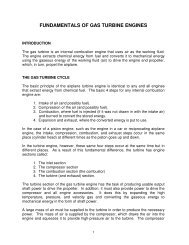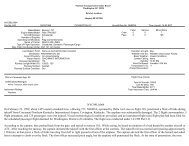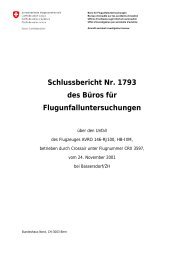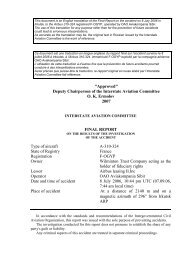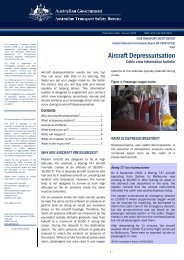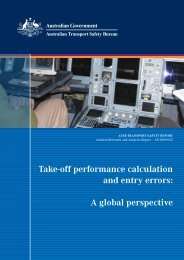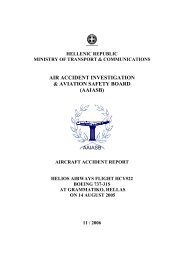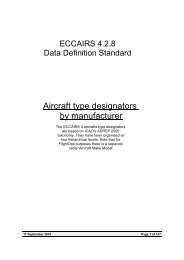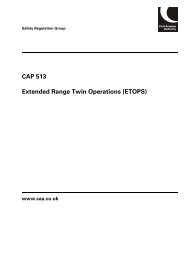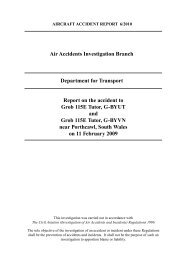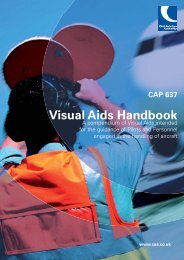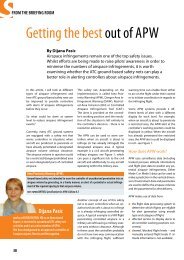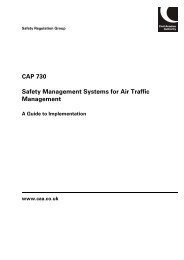CAP 772 - Birdstrike Risk Management for Aerodromes - SKYbrary
CAP 772 - Birdstrike Risk Management for Aerodromes - SKYbrary
CAP 772 - Birdstrike Risk Management for Aerodromes - SKYbrary
You also want an ePaper? Increase the reach of your titles
YUMPU automatically turns print PDFs into web optimized ePapers that Google loves.
<strong>CAP</strong> <strong>772</strong> <strong>Birdstrike</strong> <strong>Risk</strong> <strong>Management</strong> <strong>for</strong> <strong>Aerodromes</strong><br />
5.5 Landfills <strong>for</strong> Food Wastes<br />
5.5.1 Wastes from household and commercial premises contain a high proportion of waste<br />
food which, in a landfill site, supports very large numbers of Gulls. Most wastes<br />
containing food are disposed of by controlled landfilling in which they are compacted<br />
into layers around 2 m in depth and covered daily with inert material. This does not<br />
limit access by Gulls, which feed as the wastes are tipped, spread and compacted.<br />
5.5.2 Gulls congregating at landfills could contribute to the birdstrike risk to nearby<br />
aerodromes in several ways:<br />
a) when not feeding, they spend most of the day on open sites within 6 km (4 miles)<br />
or more from the landfill;<br />
b) they commonly soar up to 450 m (1500 ft) or more in clear weather; and<br />
c) they may commute between the landfill and their roost, which may involve<br />
crossing an aerodrome or its approach and departure routes.<br />
5.5.3 Corvids and Starlings also feed on landfills but their concentrations and flightlines are<br />
more local and less pronounced. They usually present no significant contribution to<br />
the birdstrike risk except where the landfill is very close to the aerodrome.<br />
5.6 Sewage Treatment and Disposal<br />
5.6.1 Modern sewage treatment plants, unlike their predecessors, do not attract large<br />
numbers of birds because of the lack of open availability of effluent.<br />
5.6.2 If the primary separation of solids from the liquid fraction is in open tanks, Gulls may<br />
visit them in relatively modest numbers. Percolating filter beds are breeding grounds<br />
<strong>for</strong> flies, and Black-headed gulls and Starlings may feed on the adult insects.<br />
5.6.3 The effluent from obsolescent or overloaded plants at some estuarine and coastal<br />
sites may contain sufficient organic solids to attract large flocks of Gulls to the<br />
outfalls. Where discharge is not continuous, but at certain times or tide states, Gulls<br />
learn the pattern and congregate at the appropriate times.<br />
5.7 Reservoirs, Lakes and Ponds<br />
5.7.1 Populations of birds with specialised aquatic habits are concentrated on and around<br />
freshwater bodies that may be relatively widely separated in the landscape. In<br />
addition, large water supply reservoirs (over 10 ha, 25 acres), canal feeder reservoirs,<br />
and other large lakes may be used as regular overnight roosts by tens of thousands<br />
of Gulls.<br />
5.8 Sand, Gravel and Clay Pits<br />
5.8.1 Mineral extraction does not itself attract birds. However, the large voids created<br />
sometimes fill with water either during working (wet extraction) or, when they are<br />
worked out, are allowed to flood and restored as amenity lakes or nature reserves.<br />
5.8.2 Sand, gravel and clay pits can sometimes be filled in with water, or their shape can<br />
be modified during or after excavation to break up the expanse of open water. Narrow<br />
causeways, piers and islands are usually insufficient and may increase the<br />
attractiveness to Gulls by providing inaccessible dry land roosting sites. Increasing the<br />
extent of shoreline by creating promontories, bays and islands increases the<br />
attraction to other waterfowl. Active scaring around dusk may remove a roost if it<br />
were to occur.<br />
March 2007<br />
Chapter 3 Page 7




